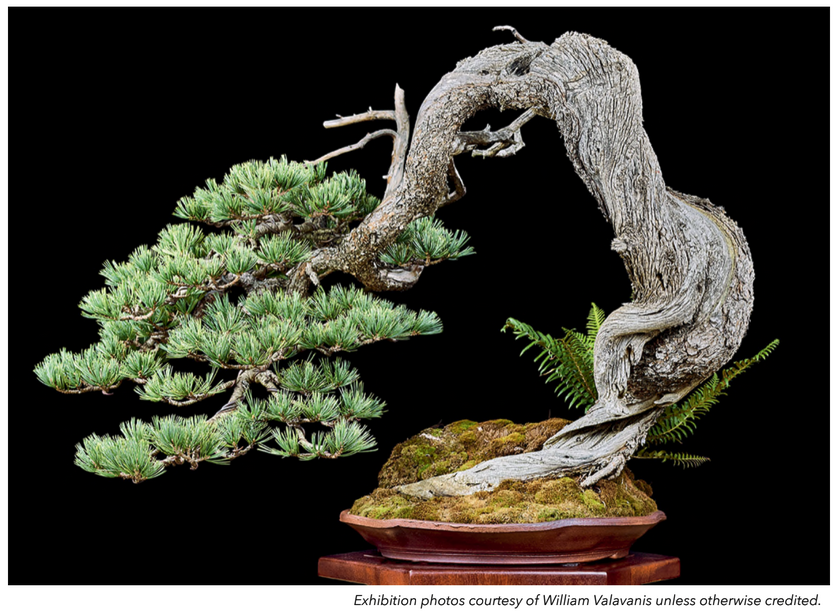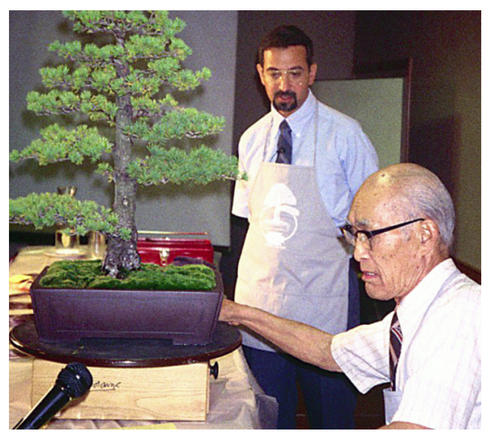Biannually, in September, there is a gathering in Rochester, New York, marking one of the most important events in the North American bonsai calendar. Some of the finest trees in the country will be on display as well as one of the largest concentrations of quality vendors. Highlights of the weekend include a series of lectures and demonstrations, an auction and awards banquet, the exhibition and vendor halls, a series of display critiques and much more.
The exhibition itself is massive. Around one half of the 50,000 ft2 facility is dedicated to a juried selection of over 200 displays, with areas dedicated to large and medium-sized bonsai, shohin, suiseki, kusamono, and much more. Most of the other half of the facility is distributed among the nearly 50 vendors on hand over the weekend. In addition to the display of trees from private collections, there are special exhibits from the U.S. National Bonsai & Penjing Museum, the Montreal Botanic Garden, the Brooklyn Botanic Garden and other important public and private collections across North America. It will take numerous circuits of the display area to appreciate all that is on offer.
Over the course of the weekend, a panel of noteworthy artists will lead tours through the exhibit hall, offering a detailed analysis and assessment of all that is on offer. A separate international panel of distinguished and experienced judges, including Koji Hiramatsu (Japan), Gerald Rainville (Canada), Corin Tomlinson (UK), and Sean Smith (U.S.), will carefully evaluate each of the many displays throughout the exhibit hall. Drawing on the breadth of their experience and their knowledge of bonsai aesthetics, they will distribute the National Award, as well as awards for best evergreen, best tropical, best North American native, finest classical bonsai and many more. These awards will be presented at the banquet and auction on Saturday night.
The dynamic spark of creative energy behind this exhibition is William Valavanis, an institution in American bonsai. For over half a century, Bill has been a tireless promoter and educator of bonsai in the United States. Between 1970 and 1972, he studied bonsai in Japan at the gardens of Kyuzo Murata, Kakutaro Komuro, and Tameji Nakajima. He also studied saikei with Toshio Kawamoto and ikebana at the Shofu School of Ikebana. Bill then enrolled at Cornell, majoring in Floriculture and Ornamental Horticulture and began a decades-long relationship, first as a mentee and then as a collaborator, with Yuji Yoshimura in Upstate New York. Thus began Bill’s lifelong dedication to promoting bonsai and sharing his passion for the art.
Bill Valavanis (left) and Yuji Yoshimura. Photo courtesy of William Valavanis.
Establishing the U.S. National Bonsai Exhibition is just one of Bill’s many accomplishments as an author, artist and teacher. We who share Bill’s passion for the art of bonsai, owe him a debt of gratitude for his efforts to raise the standards of North American bonsai and for having provided this forum for all of us to gather and mark our collective progress.
In recognition of his many accomplishments and his lifetime of contributions, the American Bonsai Society presented Bill with a richly- deserved Lifetime Achievement Award in 2003. In 2017, Bill was the third inductee to the National Bonsai & Penjing Museum’s Bonsai Hall of Fame, following John Naka and his friend and mentor, Yuji Yoshimura.
William Valavanis in 2017 at the Hall of Fame ceremony. Photo courtesy of Young Choe.
The first U.S. National Exhibition that I attended was in 2014. Having visited a number of public and private collections as well as many state and regional conventions, I was fully aware that quality bonsai existed in America. I was, however, and continue to be, astonished at the quality and quantity of excellent bonsai developed and maintained by private collectors across the country. It is these trees that are showcased at the U.S. National Bonsai Exhibition. As I walked the hall filled with stunningly beautiful trees, I was disappointed that I had missed the first three of these gatherings.
I committed right then and there to eventually showing my own trees at this event. I recall the many hours of work and planning it took to bring that about and remember my pride in seeing my own work displayed among such an excellent collection of bonsai. I now mark the event on my calendar two years in advance and am constantly asking of my best trees when they might be ready for a future U.S. National Bonsai Exhibition.
The 8th U.S. National Bonsai Exhibition is scheduled for September 9-10th, 2023 in
Rochester, NY. The National Bonsai Foundation and the American Bonsai Society stand together in support of this special event. As a showcase for the best in American bonsai, this is an opportunity to measure the quality and progress of your own collection and to reimagine how far your own artistic efforts can take you. As an educational experience, this is an opportunity to engage with some of the best American artists on how you may improve the quality of your collection and, thus, contribute to the progress of bonsai in North America. As one of the largest gatherings of artists and vendors in the U.S.,
this is an opportunity to connect with a community of people having a shared and common interest.
This is an event not to be missed. I’ll be there and I am already blocking my weekends in September 2025 for the next one.
To register for the event, visit this website.
This article was originally written by Dr. Soctt Barboza and published in the August American Bonsai Society Newsletter. Dr. Scott Barboza was introduced to bonsai by a friend while studying geology at UC Davis in the early 1990’s. Bonsai resonated with his passions for hiking, the outdoors, and gardening. He took classes in Sacramento and while in graduate school at the University of Washington. After moving to Houston in the late 1990s, Scott became a member of the Houston Bonsai Society and began studying with Boonyarat Manakitivipart with whom he has worked for many years. Scott’s trees have won awards at local, state, and regional competitions and he has exhibited trees at several national shows. He has lectured, taught, and helped to organize several conventions and exhibitions.




